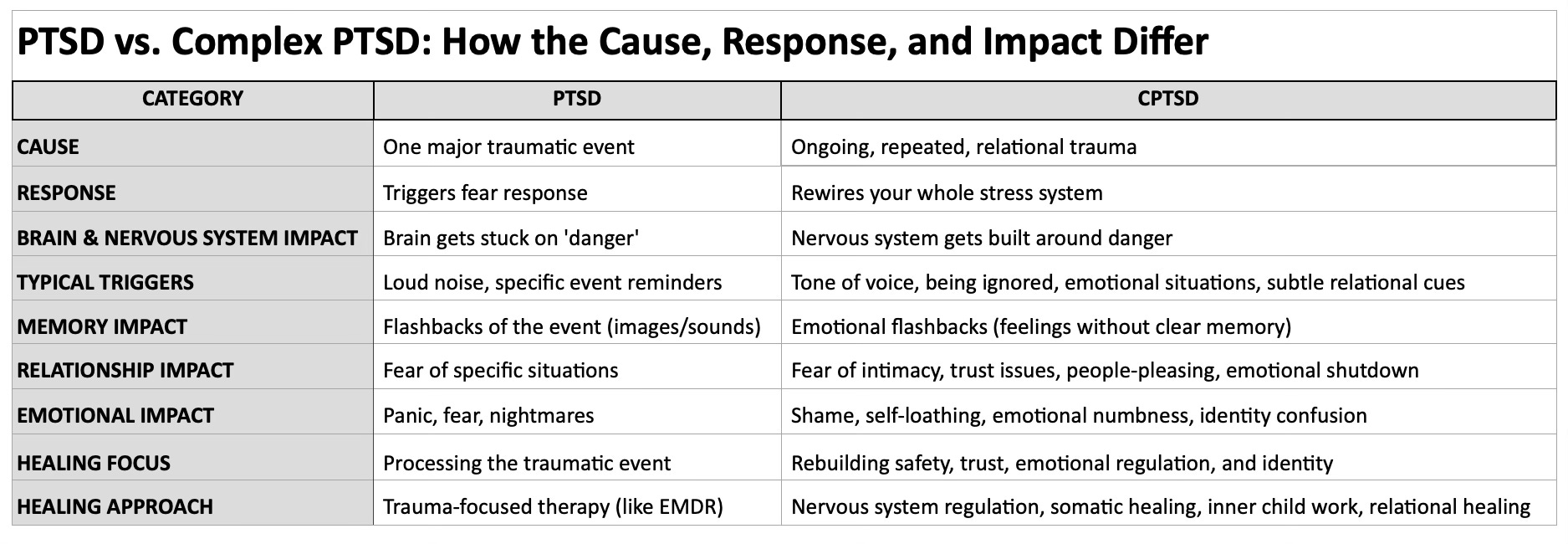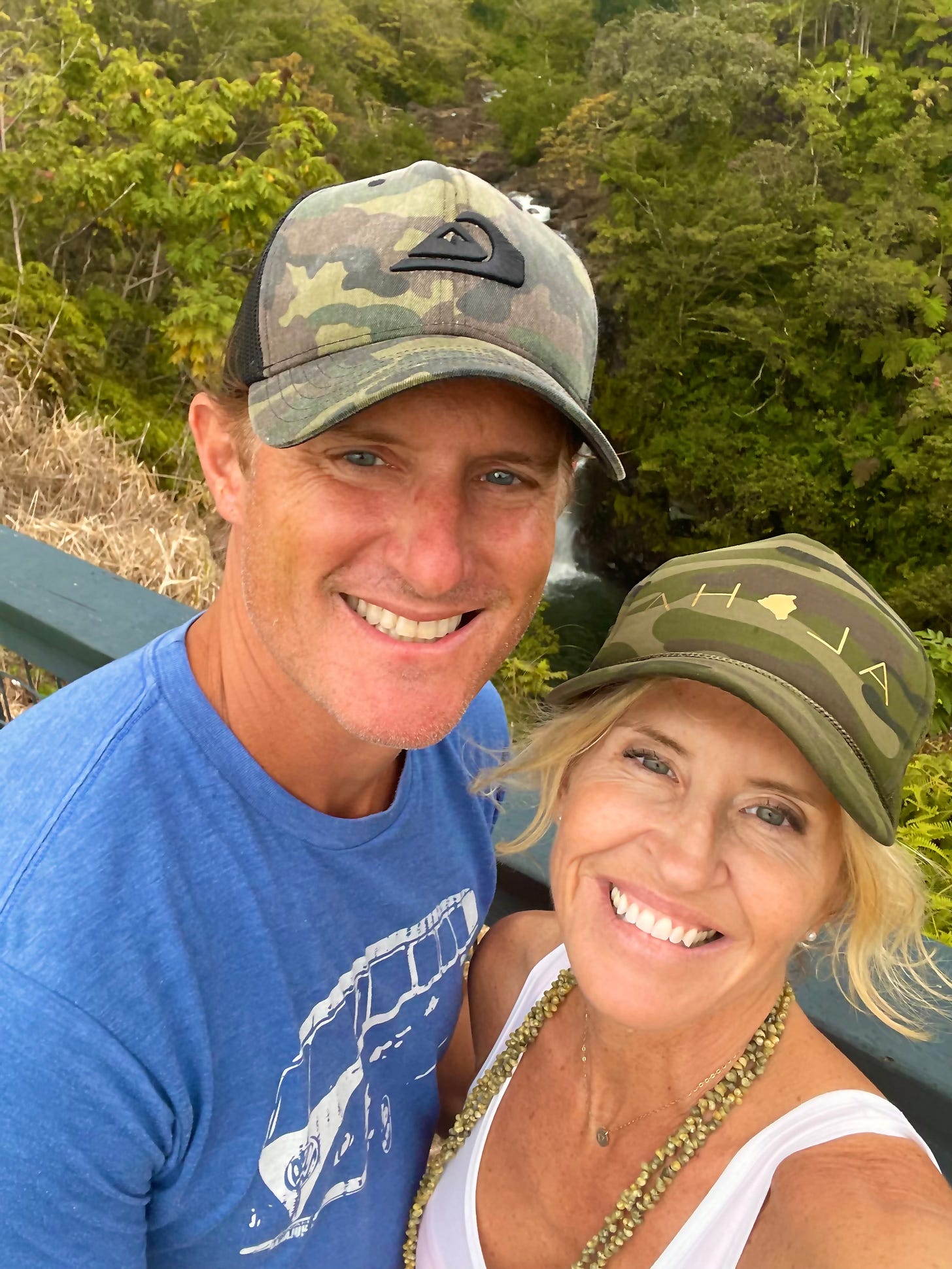Growing Up in Survival Mode Wires Your Brain Differently
How Complex PTSD reshapes your brain and body — and how you can heal.
Summary
Growing up in survival mode changes you in ways you don’t even realize until years later. This post unpacks how chronic stress wires your brain and body differently — and why the patterns you carry today aren’t your fault (or a character flaw).
How Complex PTSD reshapes your brain and body — and how you can heal.
Ever wonder why you feel anxious, on edge, or exhausted… even when life is calm?
Why your body feels tight for no reason?
Why you either shut down completely or react way bigger than you meant to?
This isn’t about being “too sensitive.”
Or overreacting.
Or broken.
This is what happens when your nervous system has been wired for survival for years.
PTSD vs CPTSD — And Why They Feel So Different
Most people have heard of PTSD — usually linked with a single, life-threatening event like war, natural disasters, or violence.
But Complex PTSD (C-PTSD) is different.
It’s not about one big traumatic event.
It’s about living in ongoing, repeated stress.
The kind that happens slowly. Quietly. Over time.
The kind that becomes normal.
Growing up in survival mode doesn’t just hurt.
It builds your brain and nervous system to expect danger all the time.
Quick Breakdown:
If you grew up with Complex PTSD?
Your brain and body didn’t just learn how to cope with stress.
They built your entire identity around staying safe.
Hypervigilance became your normal
People-pleasing became protection
Emotional shutdown became self-defense
Distrust or over-trusting became survival
This is why CPTSD isn’t just trauma.
It’s nervous system wiring.
Why Does This Matter?
Because if no one explains this to you — it’s so easy to blame yourself.
→ For being reactive.
→ For not trusting people.
→ For feeling numb or disconnected.
→ For shutting down emotionally.
→ For struggling to “just relax.”
But none of those things are character flaws.
They are survival adaptations.
They are evidence that your nervous system did exactly what it needed to do to protect you.
Understanding this was such a pivotal part of my healing.
Here’s What I Hope You Know:
→ Nothing about the way you learned to survive makes you broken.
→ It makes you brilliant. Adaptable. Resilient.
→ And now — it makes you ready to heal.
Coming Up Next in This Series:
💡 What Complex PTSD Actually Does to Your Brain (And Why It Feels So Hard to Change)
We’ll break down exactly what’s happening in your brain — in real, simple words — so you can finally understand why you feel the way you do (and why it’s not your fault).
Spoiler: It’s not “just in your head.”
It’s in your brain.
It’s in your body.
It’s in your wiring.
And healing is absolutely possible.
If this resonated with you...
I’d love to have you stick around.
Subscribe for FREE below for future posts — real stories, gentle reminders, and practical tools I teach (and use) for feeling safe in your mind & body.
And as a little thank you for subscribing — I'll send you my Free guide: 5 Grounding Techniques for Emotional Flashbacks.
📌 About Us:
We’re Kristin & Travis Francis — founders of Complex PTSD Warrior. We provide trauma-informed education & support for healing your nervous system, repairing relationships, and breaking generational cycles — with curated tools based in neuroscience & lived C-PTSD experience.
Disclaimer: The content shared here is for educational and informational purposes only and is not a substitute for professional mental health care, diagnosis, or treatment. Please go at your own pace, and always prioritize what feels safe for your body and nervous system. If you’re in crisis or need immediate support, please reach out to a licensed mental health provider or crisis resource in your area.
Sources & Further Reading
American Psychiatric Association. (2013). Diagnostic and Statistical Manual of Mental Disorders (5th ed.) (DSM-5). Arlington, VA: American Psychiatric Publishing.
Cloitre, M., Garvert, D. W., Brewin, C. R., Bryant, R. A., & Maercker, A. (2013). Evidence for proposed ICD-11 PTSD and Complex PTSD: A latent profile analysis. European Journal of Psychotraumatology, 4(1). https://doi.org/10.3402/ejpt.v4i0.20706
Herman, J. L. (1992). Trauma and Recovery: The Aftermath of Violence--From Domestic Abuse to Political Terror.Basic Books.
Van der Kolk, B. (2014). The Body Keeps the Score: Brain, Mind, and Body in the Healing of Trauma. Penguin Books.
National Center for PTSD. (2022). Complex PTSD (CPTSD). U.S. Department of Veterans Affairs. Retrieved from https://www.ptsd.va.gov/professional/treat/essentials/complex_ptsd.asp
Teicher, M. H., & Samson, J. A. (2016). Annual Research Review: Enduring neurobiological effects of childhood abuse and neglect. Journal of Child Psychology and Psychiatry, 57(3), 241–266. https://doi.org/10.1111/jcpp.12507
World Health Organization. (2018). International Classification of Diseases 11th Revision (ICD-11): Complex PTSD Criteria. Retrieved from https://icd.who.int/browse11/l-m/en#/http://id.who.int/icd/entity/585833559







I'm not even diagnosed yet, and I'm looking at ADHD, autism, autistic trauma and burnout, and CPTSD. I just want to be heard for once in my life.
So true, thanks for posting this. I know that abusive perverse parents (or just growing up with a single parent) can cause horrendous damage.
I have never heard of Somatic treatment, will investigate about it. Thanks again